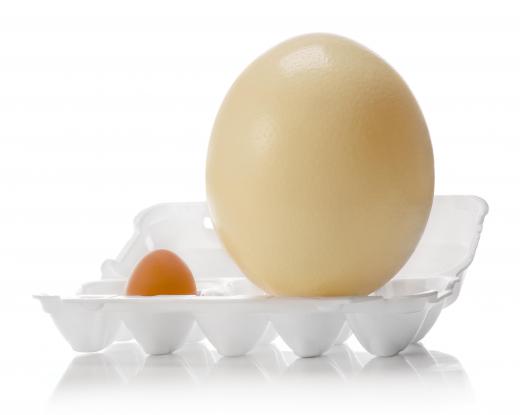What is the Largest Biological Cell?
 Michael Anissimov
Michael Anissimov
The largest biological cell is often cited as the ostrich egg, which is about 6 inches (15 cm) long and weigh about 3 pounds (1.4 kg). This is a myth. There are at least several biological cells larger than an ostrich egg, despite the fact that even many scientists and laypeople believe the ostrich egg is indeed the biggest. The ostrich may actually be the heaviest cell, but this has not yet been tested.
Largeness refers to size, not weight, so the ostrich egg is definitely not the largest. The first type of cell larger than the ostrich egg are nerve cells in especially long animals, such as the Giant Squid and Colossal Squid, which may have nerve cells as long as 39 feet (12 m), about 80 times larger than an ostrich egg. Nerve cells have very long axons, enabling the brain to send signals to distant limbs almost instantly. In giraffes, the nerve cells may be several yards (meters) long, running the whole length of the animal's neck, and in humans, the longest nerve cells are about 4.9 feet (1.5 m), running from the base of the spine to the toes. So even the human body has biological cells larger than the ostrich egg.

One might argue that, in terms of volume, an ostrich egg is still the largest in comparison to nerve cells, which may be very long but exceedingly skinny, on the order of 10 microns or less. Even ignoring nerve cells, however, there is another type of cells larger than the ostrich egg: extremely large algae like Caulerpa, which may grow to 10 feet (3 m) in length or more, a single cell that may include up to 200 fronds.

Caulerpa is one among several other algae that superficially resemble vascular plants because of their branching structure. It is a type of cell that contains numerous nuclei, which may be part of the reason it is often overlooked when the award for largest biological cell is handed out. In Indonesia, certain species are eaten as the "sea grape," and they are said to have a peppery taste, and may be eaten fresh or with sugar.
AS FEATURED ON:
AS FEATURED ON:












Discussion Comments
anon994425-- People sometimes get frustrated with this topic because the answer isn't very clear. The yolk could be considered a single cell. This doesn't mean that it resembles cells in other types of organisms. So it is not incorrect to say that an ostrich egg contains the largest single cell.
I thought that a bird egg is not a cell and have cells inside them?
I agree that largeness is typically associated with size more than weight, the immediate jump to -length- is unwarranted when volume would be more precise. And with cells being comprised mostly of water, they'd all have approximately the same density, making -weight- a better measure of the largest cell than length would be.
I think the confusion comes from high school biology - an egg is a very easy way to demonstrate what a cell looks like. It appears to have a cell wall, a cell membrane, and a nucleus. Obviously this is completely wrong - animal cells don't have cell walls so the shell isn't a good representation of this; albumen is nothing like the fluid within a cell, which contains ionic molecules to maintain fluid density and lots of organelles; and the yolk is nothing like a DNA containing nucleus.
Also, as an egg develops into a baby bird, it's not the egg that divides, it's a small embryonic cell within the egg - further demonstrating that the shell is not a cell wall and the yolk is not a nucleus. An egg is a useful tool for teaching kids, but an egg is definitely not a cell.
@anon585512: I completely agree.
Giant squid nerve cells might still win in volume; they are quite thick. What about coconuts? That's a big, heavy cell.
An ostrich egg being the largest cell is a common myth, but an ostrich egg does contain a tiny egg cell, surrounded by supportive materials such as albumin, yolk and shell. Those supportive materials are not part of the egg. It is erroneous to think of an entire ostrich egg (or chicken egg, or snake egg, etc) as a cell. The cell part itself is tiny.
@chicada- Algae are not prokaryotic. Prokaryotic cells' defining characteristic is a lack of a nucleus. There are many other differences between prokaryotic and eukaryotic cells but the nucleus is the defining characteristic. Also, fertilized eggs (zygotes) would still fall in the category of eukaryotic cells because they are one cell. An embryo, on the other hand, is a collection of cells and thus not one cell.
A cell with multiple nuclei is often called a syncytium. An ostrich egg has just one nucleus. So too would a neuron. A better way to avoid confusion is to ask what is the largest cell by volume having a single nucleus. Is this the same as the largest cell with a single nucleus by length?
@ aplenty- there are two types of cells in cellular biology, so there should probably be two different distinctions as to what the biggest biological cell is. A prokaryotic cell is self-replicating individual living unit that contains biomolecular parts bound together by a membrane. These cells are what biologists consider single celled organisms like bacteria and algae.
Eukaryotic cells on the other hand have a distinct nucleus and work with other eukaryotic cells as an individual unit in a multicellular organism. These types of cells would be the cells in our bodies, in plants, and in other animals. Eggs would fall into this category in its unfertilized state.
So what is the definition of a cell? What are the characteristics that define an ostrich egg or a spinal cord as a cell? What cell parts are necessary to qualify something as a cell?
It seems you are relating size to length alone. It would be interesting to know the volume of those very long cells. It could be that we have "winners" for length and the ostrich egg may still take the prize for volume.
Post your comments